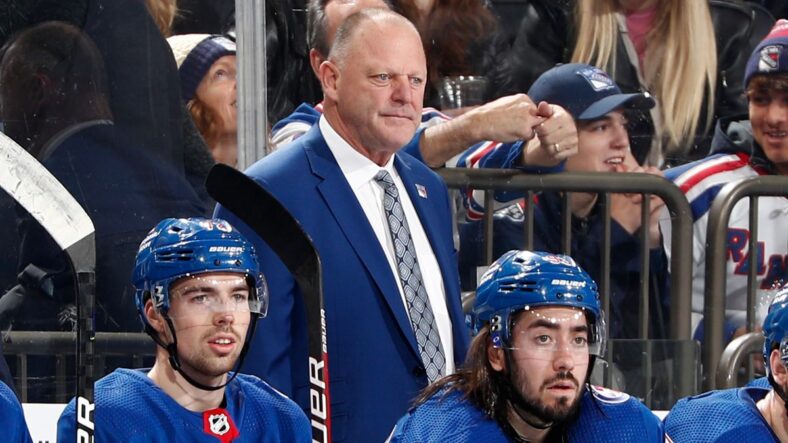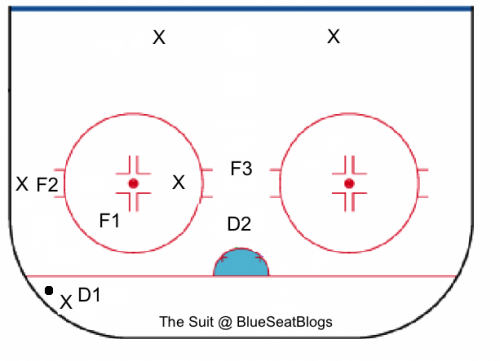
With the trade deadline approaching next month, the Rangers trade rumors have them mentioned in almost every rumor and speculative article. While this team certainly has a few holes on its roster that may need addressing (namely bottom 6 depth), some of the names being floated out there make zero sense.
To me, there’s a lot of key information and context missing from these rumors and ‘analyses’ of players who could potentially fit our roster. To help fans sift through some of this stuff, I thought I’d create a framework with which you can use to evaluate some of the trade rumors being peddled by the media.
Here’s three key components that should be considered before for any potential trade.
Does a player fit Gerard Gallant’s System?
One of the most overlooked aspects of hockey is team systems and concepts. It’s almost never mentioned on the studio shows and barely gets coverage from hockey blogs (except this one of course). And yet it’s probably one of the most important variables in identifying who is right for your roster and lineup.
While there are many aspects to a hockey system, how a team forechecks and wins back the puck is ultimately the foundation for how you play.
For the Rangers, Gerard Gallant employs a 2-1-2 or an aggressive 1-2-2 forechecking scheme and a zone based defensive structure (for more on systems, click here).

For a system like this to work, it is vital that you have centers (typically your F1s) that can play a strong two-way game and at least one winger per line that can win 50/50 pucks down low. Without them, it becomes difficult to execute 5-on-5 play.
Right now, the Rangers do not have a center that can play goal line to goal line effectively. Mika, Strome, and Chytil are all skilled players (to varying degrees), but none of them are elite at the defensive side of the puck or tracking back to help the defense.
So, what does that mean for Rangers trade rumors?
Despite all the Rangers trade rumors, trading for a two-way center may prove difficult. They are like power forwards. There just aren’t a lot of them in the league. That naturally will create a higher price to acquire at the deadline and may be a piece we have to address in the offseason.
Despite the prevailing narrative that is out there, the Rangers are in a little bit of better shape with their wingers. Kreider, Kakko, Lafrenière, and Goodrow can all hunt down pucks, finish their checks, etc. If Lafrenière can cement his role on the right side, that will make Drury’s job easier.
Assuming he does and Kakko is back prior to the deadline, I could see the Rangers acquiring a 3rd line winger to solidify the top 9. Long-term, my hope is that Brennan Othmann (who is 19 and one of the top OHL wingers) and / or Will Cuylle (20, also a top winger in the OHL) will put some pressure on Kakko and Lafrenière to take another step forward.
Until then, a short-term winger (who can play either side, be good on the forecheck, with strong skating and some skill around the net) will go a long way at fixing the 5-on-5 issues.
What role will they fill?
Another key part of the Rangers structure is having players with specific roles. This is especially true on defense, where Gallant seems to prefer having one skilled defensemen leading the rush and one who acts as a safety valve.
There are obviously some nuances here, but it’s one of the reasons why you won’t have Jones and Lundkvist as your bottom pairing, or even in the lineup, despite both being highly skilled. Neither of them is the type of player that finishes their checks, block shots, or clears the crease consistently.
Fox isn’t great at those things either, but his offense and ability to pick pockets more than makes up for it. Nils and Jones still need to overcome those deficiencies so that they are a net positive on the ice. While they are in the AHL seasoning or getting reps with the Rangers in practice, someone must fill that role next to Schneider, who seems to be getting groomed for a more advanced position.
Nemeth was supposed to be that guy, but it remains to be seen if he can get sorted. If not, the Rangers should take a flyer on a similar player who can fill that role.
Getting underneath the underlying numbers
The proliferation of advanced stats (e.g., RAPM, GAR, etc.) has certainly helped identify players who may bring more to the table than traditional stats might imply. However, those numbers still need to be viewed through a filter of systems and roles. Without that context, these numbers don’t tell you the “why” behind the outcomes.
Shutdown defensemen, defensive forwards, etc. don’t always have great underlying numbers. Those players on bad teams or are playing in more defensive systems will never compare to players in opposite situations. Context matters.
In the end, I’m not expecting Drury to be too aggressive on the trade front, despite the Rangers trade rumors out there. Unless he isn’t high on some of the upcoming talent like a Lafrenière or a Miller, I have a hard time seeing him go for broke at the deadline.
The smart move is probably to shore up the depth and see what this team can do in the postseason. If the Rangers get 86’d in the first round, then maybe you go for that 2-way center in the offseason or a top 6 RW. Until then, it’s probably more tactful moves.
Share:
More About:Hockey Tactics State of the Rangers
